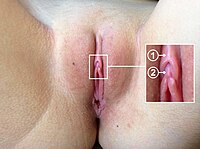
Photo from wikipedia
PURPOSE The purpose of our study was to describe the symptom profile of patients who presented to a tertiary care hospital for sling revision, define the efficacy of sling removal/revision… Click to show full abstract
PURPOSE The purpose of our study was to describe the symptom profile of patients who presented to a tertiary care hospital for sling revision, define the efficacy of sling removal/revision in alleviating symptoms and identify what factors, if any, contribute to favorable surgical outcomes. MATERIALS AND METHODS We retrospectively reviewed the records of patients who underwent revision of a synthetic mid urethral sling at our institution between 2004 and 2016. Patients with a history of vaginal mesh for pelvic organ prolapse were excluded from analysis. The outcomes assessed were the AUASI (American Urological Association Symptom Index) score, the M-ISI (Michigan Incontinence Symptom Index) score, pad use, post-void residual urine volume, examination findings and subjective improvement. RESULTS A total of 430 patients met study inclusion criteria, of whom 182, 172 and 40 received a transobturator tape, a retropubic mid urethral sling and a mini-sling, respectively. Patients presented with 4 primary complaints, including mesh exposure or erosion, pain or dyspareunia, incontinence and/or bladder outlet obstruction. Of the patients 77% presented with at least 2 categories of symptoms. Average followup was 15 months. Postoperatively the AUASI score decreased from 19.0 to 14.7 (p <0.001) and the AUA bother score decreased from 5.0 to 3.4 (p <0.001). The M-ISI also improved from total and bother scores of 15.7 and 4.4 to a postoperative average of 13.2 and 3.1 (p = 0.002 and <0.001, respectively). During this time approximately 40% of patient who presented with pain had persistent postoperative discomfort, in 20% with obstruction that condition failed to resolve and recurrent mesh complaints developed in 5% with mesh exposure or erosion. On multivariate analysis preoperative narcotic use was a significant risk factor for persistent postoperative pain (OR 6.9). CONCLUSIONS Despite complex patient presentations subjective and objective urological symptom measures significantly improve following mid urethral sling revision.
Journal Title: Journal of Urology
Year Published: 2019
Link to full text (if available)
Share on Social Media: Sign Up to like & get
recommendations!